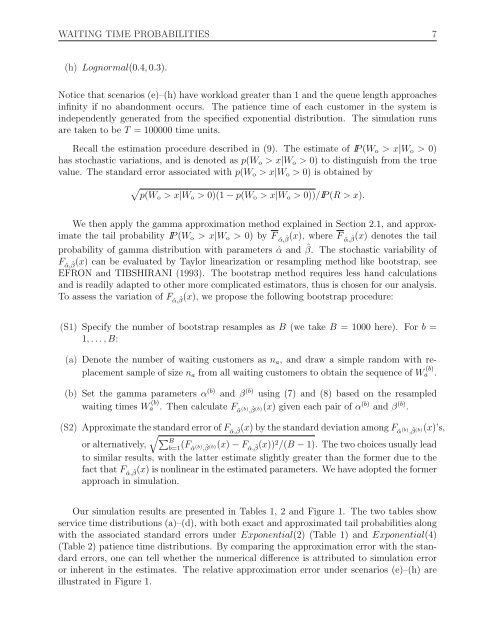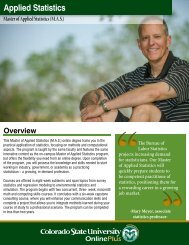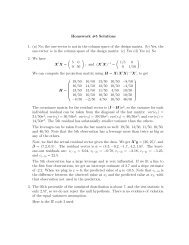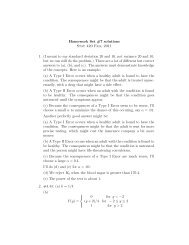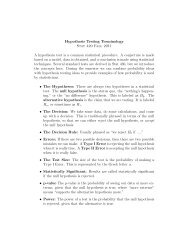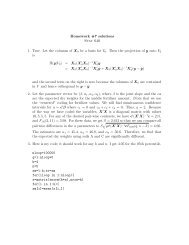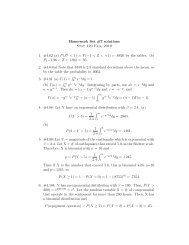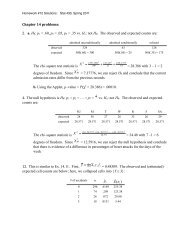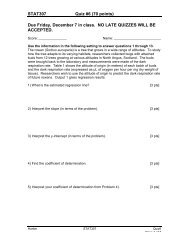Waiting time probabilities in the M/G/1 + M queue - Statistics ...
Waiting time probabilities in the M/G/1 + M queue - Statistics ...
Waiting time probabilities in the M/G/1 + M queue - Statistics ...
Create successful ePaper yourself
Turn your PDF publications into a flip-book with our unique Google optimized e-Paper software.
WAITING TIME PROBABILITIES 7<br />
(h) Lognormal(0.4, 0.3).<br />
Notice that scenarios (e)–(h) have workload greater than 1 and <strong>the</strong> <strong>queue</strong> length approaches<br />
<strong>in</strong>f<strong>in</strong>ity if no abandonment occurs. The patience <strong>time</strong> of each customer <strong>in</strong> <strong>the</strong> system is<br />
<strong>in</strong>dependently generated from <strong>the</strong> specified exponential distribution. The simulation runs<br />
are taken to be T = 100000 <strong>time</strong> units.<br />
Recall <strong>the</strong> estimation procedure described <strong>in</strong> (9). The estimate of IP (W o > x|W o > 0)<br />
has stochastic variations, and is denoted as p(W o > x|W o > 0) to dist<strong>in</strong>guish from <strong>the</strong> true<br />
value. The standard error associated with p(W o > x|W o > 0) is obta<strong>in</strong>ed by<br />
√<br />
p(Wo > x|W o > 0)(1 − p(W o > x|W o > 0))/IP (R > x).<br />
We <strong>the</strong>n apply <strong>the</strong> gamma approximation method expla<strong>in</strong>ed <strong>in</strong> Section 2.1, and approximate<br />
<strong>the</strong> tail probability IP (W o > x|W o > 0) by F ˆα, ˆβ(x), where F ˆα, ˆβ(x) denotes <strong>the</strong> tail<br />
probability of gamma distribution with parameters ˆα and ˆβ. The stochastic variability of<br />
Fˆα, ˆβ(x) can be evaluated by Taylor l<strong>in</strong>earization or resampl<strong>in</strong>g method like bootstrap, see<br />
EFRON and TIBSHIRANI (1993). The bootstrap method requires less hand calculations<br />
and is readily adapted to o<strong>the</strong>r more complicated estimators, thus is chosen for our analysis.<br />
To assess <strong>the</strong> variation of Fˆα, ˆβ(x), we propose <strong>the</strong> follow<strong>in</strong>g bootstrap procedure:<br />
(S1) Specify <strong>the</strong> number of bootstrap resamples as B (we take B = 1000 here). For b =<br />
1, . . . , B:<br />
(a) Denote <strong>the</strong> number of wait<strong>in</strong>g customers as n a , and draw a simple random with replacement<br />
sample of size n a from all wait<strong>in</strong>g customers to obta<strong>in</strong> <strong>the</strong> sequence of W (b)<br />
a .<br />
(b) Set <strong>the</strong> gamma parameters α (b) and β (b) us<strong>in</strong>g (7) and (8) based on <strong>the</strong> resampled<br />
wait<strong>in</strong>g <strong>time</strong>s W (b)<br />
a . Then calculate Fˆα (b) , ˆβ (b) (x) given each pair of α (b) and β (b) .<br />
(S2) Approximate <strong>the</strong> standard error of Fˆα, ˆβ(x) by <strong>the</strong> standard deviation among Fˆα (b) , ˆβ (b) (x)’s,<br />
or alternatively,<br />
√ ∑B<br />
b=1 (Fˆα (b) , ˆβ (b) (x) − Fˆα, ˆβ(x)) 2 /(B − 1). The two choices usually lead<br />
to similar results, with <strong>the</strong> latter estimate slightly greater than <strong>the</strong> former due to <strong>the</strong><br />
fact that Fˆα, ˆβ(x) is nonl<strong>in</strong>ear <strong>in</strong> <strong>the</strong> estimated parameters. We have adopted <strong>the</strong> former<br />
approach <strong>in</strong> simulation.<br />
Our simulation results are presented <strong>in</strong> Tables 1, 2 and Figure 1. The two tables show<br />
service <strong>time</strong> distributions (a)–(d), with both exact and approximated tail <strong>probabilities</strong> along<br />
with <strong>the</strong> associated standard errors under Exponential(2) (Table 1) and Exponential(4)<br />
(Table 2) patience <strong>time</strong> distributions. By compar<strong>in</strong>g <strong>the</strong> approximation error with <strong>the</strong> standard<br />
errors, one can tell whe<strong>the</strong>r <strong>the</strong> numerical difference is attributed to simulation error<br />
or <strong>in</strong>herent <strong>in</strong> <strong>the</strong> estimates. The relative approximation error under scenarios (e)–(h) are<br />
illustrated <strong>in</strong> Figure 1.


